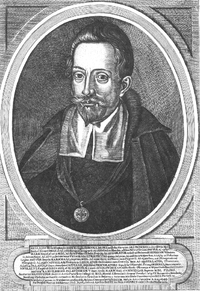Mikołaj Krzysztof the Orphan Radziwiłł
Prince Krzysztof Radziwiłł'>Mikołaj Krzysztof Radziwiłł or Nicholas Christopher Radziwill aka "Sierotka" (The Orphan) (1549–1616) was a Polish-Lithuanian noble. He was Ordynat of Nieśwież from 1586. He was also Court Marshal of Lithuania from 1569, Grand Marshal of Lithuania from 1579, castellan of Trakai from 1586, voivode of Trakai Voivodeship from 1590, voivode of Vilnius Voivodeship from 1604 and Starost of Šiauliai. After the treaty at Vienna in 1515 all Radziwills were Imperial Princes and he held a position as Imperial Prince of the Holy Roman Empire. He married Halaszka Eufemia Wiśniowiecka on November 24, 1584, a Calvinist who under his influence too converted to Roman Catholicism. He took part in the Livonian War against Muscovites. In 1573 he was a member of a diplomatic mission to France to the future king of Poland, Henryk Walezy. Unlike many other members of Radziwiłł family he tried to stay away from politics, especially from the dynastic clan politics of some of other Radziwiłłs like Janusz Radziwiłł; he also supported the forces loyal to the king and Polish-Lithuanian Commonwealth during the Rokosz Zebrzydowskiego, a szlachta's confederatio threatening the king. He attempted to convince the confederates to surrender without unnecessary bloodshed. Like other members of the Radziwiłłs family, he couldn't escape the political ambitions of his family, and when needed, he would support it. He campaigned for, successfully, for a royal pardon for his cousin Janusz, one of the organisers of the Rokosz. However, he also refused to support the Krzysztof 'Piorun' Radziwiłł, whose conflict with another powerful family threatened to plunge Lithuanian into a civil war. Mikołaj became famous for a vivid account of his eventful pilgrimage to the Holy Land published in 1601, entitled Podróż do Ziemi Świętej, Syrii i Egiptu 1582-1584 (The trip to Holy Land, Syria and Egypt 1582-1584). During his voyage he visited not only Palestine, but also Syria, Egypt, Crete, Cyprus, Italy, and Greece. Robert Burton while on the subject of St. Elmo's fire wrote of this voyage in his Anatomy of Melancholy: "Radzivilius, the Polonian duke, calls this apparition, Sancti Germani sidus; and saith moreover that he saw the same after in a storm, as he was sailing, 1582, from Alexandria to Rhodes". While in Rome, he met Piotr Skarga and Stanislaus Hosius, who convinced him to convert from Calvinism to Catholicism, as later did his other brothers, many upon his insistence. He was also known for his cultural and charity sponsorships. He was a founder of many cloisters, hospitals and churches. One of the chapels in the Jesuit church in Nieśwież (now Nesvizh), founded by Mikołaj Krzysztof, would became the family's mausoleum for the Radziwiłłs, serving them for the next two hundred and a half centuries. In Nieśwież, which became his seat, he also built Nesvizh Castle. He was a patron of artists and scientists; for example he supported the works of cartographers such as Tomasz Makowski.
Personal facts

| Birth date | August 02, 1549 |
|---|---|
| Birth place | |
| Date of death | February 28, 1616 |
| Place of death | |
| Parents | Elżbieta Szydłowiecka Mikołaj the Black Radziwiłł |
| Children |
Search
Mikołaj Krzysztof the Orphan Radziwiłł on Wikipedia
External resources
- http://asoby.iatp.by/cont.phtml?x=mrs
- http://jivebelarus.net/at_this_day/birth-of-mikolaj-krzysztof-the-orphan-radziwill.html
- http://media.catholic.by/nv/n11/art9.htm
- http://www.arche.by/by/page/science/9570
- http://www.bspu.unibel.by/teacher/Maliugin/Ancient2/Radzivil.html
- http://www.radziwill.by/index.php?option=com_content&view=article&id=21:2010-05-23-16-34-37&catid=8:1-&Itemid=7
- https://commons.wikimedia.org/wiki/Category:Miko%C5%82aj_Radziwi%C5%82%C5%82_the_Orphan?uselang=be-tarask